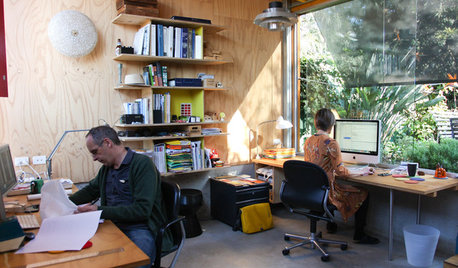Old-world knowledge...
cammunizm
12 years ago
Related Stories

ROOFSRoof Materials: Get an Old-World Look With Clay Roof Tiles
The ancient roof material of choice remains the modern-day ideal for authentic Italian, Mediterranean and Spanish home styles
Full Story
HOME OFFICESWorld of Design: 11 International Architects in Their Home Offices
Thinking about relocating your office to your home? From Sydney to Copenhagen, these architects share their insider knowledge
Full Story
PRODUCT PICKSGuest Picks: Everything Old-World Is New Again
Give even a new build a romantic history with lighting fixtures, hardware and drapes that recall the Old Country
Full Story
LIGHTINGWarm Up Your Home with Old-World Wrought Iron Lighting
Traditional chandeliers, pendants, orbs and lanterns glow with European Style
Full Story
HOUZZ TOURSHouzz Tour: An Old-World Bungalow Earns a New Plan
With a hundred years under its belt, this New Hampshire home deserved the loving additions and modern updates made by its architect owner
Full Story
Teach Old-World Style New Tricks
Layer modern, minimalist accents with antiques and traditional decor for rave-earning style contrast
Full Story
TRADITIONAL HOMESHouzz Tour: Antiques and Old-World Luxury in the San Francisco Hills
Traditional furnishings and muted colors complement European architecture in a beautifully remodeled 1912 house
Full Story
HOUZZ TOURSMy Houzz: Sophisticated, Old-World Charm for a Dallas Rambler
Warm wood tones and secondhand finds shine in this first-time homeowner’s home
Full Story
DECORATING GUIDESGet Cozy with Traditional Old-World Decorating
As winter approaches, it's time for a return to the past for warmth and comfort
Full Story
HOUZZ TOURSHouzz Tour: Old World Style Gets an Airy Update
Get Design Inspiration From an Atlanta Home's Layers of Beautiful Detail
Full Story




tinael01
amberroses
Related Discussions
design for an old world
Q
What exactly does old world vs new world Salvias mean?
Q
Wanting to grow old world roses.. need help...
Q
What would you do? sprucing Old World Living Room.
Q
scents_from_heaven
tinael01
saldut
coffeemom
loufloralcityz9
corar4gw
Yme405
hejerry
tinael01
dirtygardener73
amberroses
pnbrown
tinael01
Tiffany, purpleinopp Z8b Opp, AL
gardengimp
pnbrown
saldut
rainy230
Yme405
tinael01
tomncath
garyfla_gw
Yme405
tinael01
garyfla_gw
Yme405
gardengrl
garyfla_gw
Yme405
Tiffany, purpleinopp Z8b Opp, AL
pnbrown
cammunizmOriginal Author
pnbrown
garyfla_gw